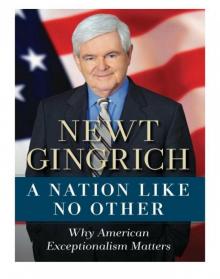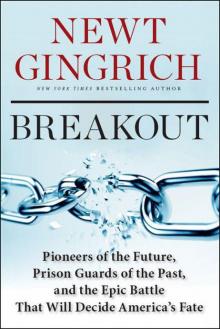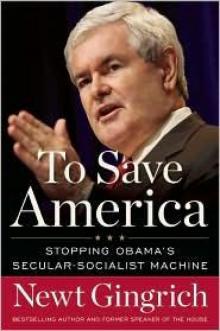- Home
- Newt Gingrich
Understanding Trump Page 19
Understanding Trump Read online
Page 19
Just look at what happened after we lowered the capital gains tax in 1997. According to the Tax Foundation, the effective capital gains tax rate in 1996 was 25.5 percent.2 We were able to gradually lower it by 5 percentage points by 1999. The Wall Street Journal reported in October 2007 that the Joint Committee on Taxation said at the time the federal government would collect $195 billion in revenue from the capital gains tax from 1997 to 1999. In truth, lowering the rate spurred businesses to invest and we collected $279 billion in those three years.
More important than increased revenue, for three years, we saw over 4 percent GPD growth, with 6.7 million new jobs created3 and median household incomes rising from $54,506 in 1997 to $57,909 in 1999.4 The impact of the capital gains tax cut in the 1990s was an economic boost felt by the entire country, not just wealthy investors.
Cutting the capital gains by just 5 percent did all that. The economic growth that would result from eliminating the tax completely would drive the United States into a new era of prosperity.
As President John F. Kennedy said, the capital gains tax “directly affects investment decisions, the mobility and flow of risk capital” and limits potential economic growth. It is ironic that Kennedy understood what today’s Democrats do not.
Congress and President Trump should act quickly to eliminate the capital gains tax, so investments and growth in America can begin as soon as possible.
REPATRIATION OF US MONEY HIDING IN FOREIGN COUNTRIES
President Trump also wants to offer companies a low-cost option to repatriate (or bring back to the United States) money they have earned overseas.
Repatriation of foreign earnings is really a no-brainer. According to the Wall Street Journal, over $2.5 trillion is being held overseas by companies that do not want to pay our high 35 percent corporate tax rate.
It’s worth noting that the United States is one of only a few countries that tax active foreign earnings. This is part of the reason that the US system is so broken. First, we have trade agreements that encourage businesses to build outside our country, then we have a tax on foreign earnings, which gives them a reason to continue to invest outside the US rather than bring earnings home. Bringing that money back to the United States would spark an investment boom that would create jobs, raise the value of the dollar, and boost 401(k)s and pensions.
It is important, however, that corporate taxes are lowered and capital gains and foreign earnings taxes are abolished first before any one-time repatriation deal.
When Congress passed the Homeland Reinvestment Act, a tax holiday to repatriate earnings from overseas, companies brought roughly $300 billion back to the United States in 2005, according to a report by National Bureau of Economic Research.
The repatriated money went back to shareholders, who invested overseas again in anticipation of the next tax holiday, because American tax policy encouraged them to do so. For real, sustained investment, we need to create a strong business environment first.
CUTTING THE INCOME TAX
There cannot be a meaningful tax cut unless it grants relief to the middle class. President Trump has presented a plan to dramatically simplify the tax code and reduce the tax rates on income. The president’s proposal would reduce the number of tax brackets from seven to three. The highest tax rate would be reduced from almost 40 percent to 33 percent. The middle-income tax bracket would be 25 percent, and the low-income bracket would be 12 percent.
Trump has also proposed eliminating the estate tax (also known as the death tax), the head-of-household filing status (which has had the perverse effect of incentivizing lower-income families not to marry), and, of course, all taxes associated with Obamacare. At the same time, he wants to more than double the standard deduction from $6,300 to $15,000 for single payers and from $12,600 to $30,000 for married couples.
Greatly reducing the tax burden on Americans will immediately spur savings, household buying power, and help reduce family debt.
In fact, President Trump’s plan looks a lot like President Reagan’s tax policy.
When Reagan took office, he was facing an economic disaster left by Jimmy Carter’s administration. In 1980, inflation had reached 13.5 percent, and the prime interest rate was at 21.5 percent—which drove home mortgage interest to 14.7 percent. By the end of Carter’s time in office, unemployment was nearing 10 percent, and 15.2 percent of Americans lived in poverty.
To spur economic growth, President Reagan immediately worked with Congress to cut the top tax rate from 70 percent to 50 percent. He then implemented a 25 percent across-the-board tax cut. With the passage of the 1986 tax reforms, there were only two tax rates: one at 28 percent and one at 15 percent.
President Reagan also aggressively cut spending, and greatly reduced red tape in Washington—all things President Trump has pledged to do. The result of Reagan’s recovery was a seven-year boom that lasted from 1982 to 1990—until a tax increase that year ended the run. In that time, the US economy grew by one-third, the country added twenty million jobs, inflation dropped to 3.2 percent by 1983, and the prime interest rate dropped to 8.2 percent by 1987—eventually getting down to 6.25 percent by 1992.
At the same time—disproving the Left’s dour predictions—federal revenue doubled from 1980 to 1990, reaching more than $1 trillion.
THE TRUMP RALLY
Business leaders and investors responded to the election of Donald Trump by betting on America again.
Just look at how the stock market has reacted to Trump’s victory. On February 16, 2017, after Trump’s first month in office, CNN Money reported that the S&P 500 increased by 3.8 percent. The S&P 500 index marks the performance of 500 commonly held stocks.
“That’s the biggest increase for a new Republican president since the blue chip index that eventually became the S&P 500 debuted in 1923, according to S&P DJ Indices,” wrote CNN’s Paul R. La Monica.
That represented the largest postelection market rally on the S&P 500 since Lyndon Johnson took office after the assassination of John F. Kennedy in 1963.
The Dow Jones Industrial Average, the nation’s oldest stock market index, closed at a record high of 21,115.55 on March 1, 2017, according to the website Thebalance.com. In fact, the Dow had thirty-two record-high closings from the 2016 election to March 1, the website reported.5 The Dow tracks the average daily price changes of thirty large American businesses. This trend started just five days after Trump was elected, when the Dow closed above 20,000 points for the first time in its history. The Nasdaq 100, which is a measure of equity securities from 100 large nonbank businesses, also closed at a record high on March 13.
The US Bureau of Labor Statistics reported 235,000 new jobs in February 2017—well over the 195,000 expected by Wall Street bean counters. And the nation’s economy added 227,000 jobs the month President Trump was inaugurated—which shattered the 175,000-job projection touted by economists.
The immediate growth to the economy following Trump’s election has prompted the Federal Reserve Bank to increase interest rates for the third time since the Great Recession—and the second time in the previous three months.
The market quickly and enthusiastically reacted to Trump’s election—along with the Republican majorities in the House and Senate—because business leaders know that they will soon see an end to anti-business, anti-growth, anti-investment policies in Washington.
This bull market and strong job numbers are a direct reaction to Trump’s election, because businesses and investors across the world are more confident about the future of the United States than they have been in decades. Business leaders know that President Trump will make good on his promises to dramatically lower taxes and give US companies an option to repatriate money they’ve guarded overseas from liberal wealth redistributors.
REGULATIONS
President Trump has initiated a search-and-destroy mission to find and eliminate federal regulations that make it needlessly difficult to do business in the United States. As Trump promised during th
e campaign, “Any regulation that is outdated, unnecessary, bad for workers, or contrary to the national interest will be scrapped.”
This is a serious challenge. According to the Competitive Enterprise Institute, in 2013, the Code of Federal Regulations—which catalogs every current federal rule—was more than 175,000 pages long. The group also estimated that the total cost of compliance to regulations is $1.8 trillion per year. In more personal terms, a family making $49,705 per year sees $14,768—30 percent of their household budget—lost to the cost of regulations embedded in their normal expenditures. Meanwhile, small businesses face costs of over $10,000 per employee for regulatory compliance.
The compounding effect of this regulatory burden is astonishing. A study in the Journal of Economic Growth found that the growth in the regulatory burden in the United States since 1949 cost the country an average of 2 percent economic growth per year. Over nearly seventy years, that meant the US economy is only “28 percent of what it would have been had regulation remained at its 1949 level.”
Reason magazine translated what that would mean for American families. According to its analysis, the median household income would be $330,000 a year had the regulatory burden not increased. Even if that analysis is off by 50 percent, and the median family income was $115,000 per year, how much better off would we be? That is the cost of the current insane regulatory regime.
If our country is going to continue to lead the world, the federal government needs to get out of the way of innovators, entrepreneurs, and others who are seeking to grow wealth in the United States and compete in science and invention worldwide.
Trump is off to a great start by working with Congress to use the Congressional Review Act to overrule Obama-era regulations issued by government agencies. The law, passed in 1996 when I was Speaker as part of the Contract with America agenda, had been used just one time before Trump assumed office. As of the date of this writing, Trump and the Republican Congress have used it six times. The regulations they have repealed include burdensome requirements on energy development, rules that removed authority from communities over zoning, and layers of bureaucracy imposed on state and local school systems.
Members of Congress could also help the president by aggregating bad regulations they hear about from constituents. Each congressperson should set up a website to crowdsource bad regulations from businesses and residents in his or her district. With enough forethought and organization, these websites could automatically find and sort the regulations that make it more difficult to grow and keep jobs in our congressional districts. From there, members of congress can compare notes and start tackling the top job-killing regulations.
To really end the job-killing nature of the regulatory state, however, it won’t be enough to eliminate regulations one by one. The underlying philosophy behind how regulations are crafted will need to be changed.
The legal and political scholar Philip Howard wrote an op-ed in the Washington Post in December 2016 describing the over-regulation problem called “Six Presidents Have Failed to cut Red Tape. Here’s How Trump Could Succeed.”6 In his op-ed, Howard said that for the last fifty years, leaders on both sides of the aisle have failed to cut unnecessary regulations, because they all approached the problem with a “flawed philosophy”:
What reformers have missed is that regulatory failure is not merely a matter of too much regulation but is caused by a flawed philosophy on how to regulate. Both sides assume that human responsibility should be replaced by what is called “clear law.” By striving to prescribe every possible good choice, and proscribe every possible evil, U.S. regulation became an obsessive exercise in micromanagement. That’s why rulebooks are often 1,000 pages, while the Constitution is 15. The evil to be exorcised by all these legal dictates is human authority. Only by lashing each other tightly with detailed law can liberal and conservative politicians be sure that the other side won’t do something bad.
Howard perfectly identified this pervasive philosophy of government control as the reason businesses in virtually every industry have to spend huge amounts of money on compliance, and why virtually every government-run initiative fails.
President Trump can change this system, Howard says, by getting rid of instruction-manual-style regulations and replacing them with simple regulations that allow human beings to focus on outputs—or results:
The solution—the only solution—is to retool regulation to focus on results, not inputs. Find any good school, any good agency, and you will find people who take responsibility for getting the job done. Experts at the Federal Aviation Administration certify planes as “airworthy” based on their expert judgment, not compliance with detailed specs on, say, how many rivets per square foot. Teachers at good schools typically say that the principal encourages them to do what they think is best and not worry about complying with many forms and metrics.
If President Trump can work with Congress to develop a doctrine and methodology of results, rather than input-focused regulations, he will have permanently changed the big-government, bureaucrats-know-best regulatory regime, and would put America on a path of sustained prosperity for decades to come.
JOBS, JOBS, JOBS
In some ways, Trump’s focus on job creation has led him to behave more like a governor than a president. Governors spend much of their time searching for companies that are looking to relocate or build new facilities, then convincing those companies that his or her state is the best choice for them. Trump has been doing this since he was campaigning—only Trump has mostly been persuading companies that had announced plans to move operations outside the United States to stay.
In December, before President Trump took office, he and Vice President Pence worked out a deal with Carrier, which makes air conditioners and other heating- and refrigeration-related products, to save about eight hundred jobs that were slated to be moved from Indiana to Mexico. As part of the deal, the company would receive $7 million of tax incentives over ten years, in exchange for investing $16 million in an Indiana facility that manufactures furnaces.
In early January, Ford Motor Company’s CEO, Mark Fields, said the automaker would cancel plans to build a plant in Mexico and instead invest $700 million in a Michigan plant. CNN Money reported the decision was made as a “vote of confidence” that President Trump would create a probusiness environment in the United States.
Critics on the Left have downplayed the retained jobs, saying that these instances won’t greatly affect the overall job market. But these jobs make a huge difference to the people who live in Michigan and Indiana who were facing unemployment.
President Trump’s plan to build $1 trillion worth of infrastructure will immediately create good-paying construction jobs all over the country. And this is a part of the president’s agenda that will attract strong bipartisan support. There isn’t a member of Congress or senator anywhere who doesn’t need infrastructure improvements in his or her district or state. Implementing President Trump’s infrastructure plan is going to be key to building and maintaining legislative momentum—and developing an environment in Congress in which Democrats and Republicans can start working together again.
JOB TRAINING AND EDUCATION
But it will do no good to create jobs if no one can do them. An often-overlooked problem with American employment is a serious lack of skilled laborers. According to Bureau of Labor Statistics data, there were 148,000 unfilled construction jobs and 325,000 unfilled manufacturing jobs in the United States in December 2016.7
One of the reasons these good-paying jobs are going unfilled is a growing lack of respect for vocational programs. We have missed out on nearly a generation of skilled workers who were convinced to attend a traditional four-year university. Curbed.com, a website that focuses on real estate and construction issues, said in an article on February 1, 2017, that this gap may come to the forefront of President Trump’s agenda:8
The labor shortage in the construction industry is indicative of a wider, decades-in-th
e-making gap in vocational training that has had an impact on many sectors of the U.S. economy. At a time when the incoming administration is talking about massive infrastructure investments and helping the rural economy, action on this issue could have a massive impact on the effectiveness of such programs. It may even impact his signature campaign promise and construction challenge, building the Mexican border wall; many industry analysts and observers say labor shortages and the need to vet legal workers for such a massive public works project will be a huge challenge.
Aside from instructing Education Secretary Betsy DeVos to look into ways to help states restore vocational training in K–12 education, President Trump could immediately start to solve the shortage of skilled workers by reversing the Obama administration’s debilitating policies over private career training programs.
The Obama administration shut down ITT Technical Institute, which had helped train American workers in skilled labor for more than fifty years. This pulled the rug out from under about forty thousand students and eight thousand employees, according to a September 20, 2016, Washington Post editorial.
And just before the end of his term, President Obama’s education department pulled authority from one of the country’s oldest national academic accreditors, the Accrediting Council for Independent Colleges and Schools (ACICS). The ACICS accredits 725 schools, which serve more than 600,000 students.
These actions were part of what the Washington Post called Obama’s “ideological crusade” against private, for-profit career-training institutions. If President Trump can quickly remove federal hurdles to career-training institutions, we could start to relieve the shortage of skilled labor in the United States.

 1945
1945 Collusion
Collusion Trump's America
Trump's America Shakedown
Shakedown A Nation Like No Other
A Nation Like No Other To Try Men's Souls - George Washington 1
To Try Men's Souls - George Washington 1 Pearl Harbor: A Novel of December 8th
Pearl Harbor: A Novel of December 8th Valley Forge: George Washington and the Crucible of Victory
Valley Forge: George Washington and the Crucible of Victory To Save America
To Save America Grant Comes East cw-2
Grant Comes East cw-2 Victory at Yorktown: A Novel
Victory at Yorktown: A Novel Days of Infamy
Days of Infamy The Battle of the Crater: A Novel (George Washington Series)
The Battle of the Crater: A Novel (George Washington Series) Breakout: Pioneers of the Future, Prison Guards of the Past, and the Epic Battle That Will Decide America's Fate
Breakout: Pioneers of the Future, Prison Guards of the Past, and the Epic Battle That Will Decide America's Fate Pearl Harbour and Days of Infamy
Pearl Harbour and Days of Infamy Pearl Harbour - A novel of December 8th
Pearl Harbour - A novel of December 8th Understanding Trump
Understanding Trump To Save America: Abolishing Obama's Socialist State and Restoring Our Unique American Way
To Save America: Abolishing Obama's Socialist State and Restoring Our Unique American Way